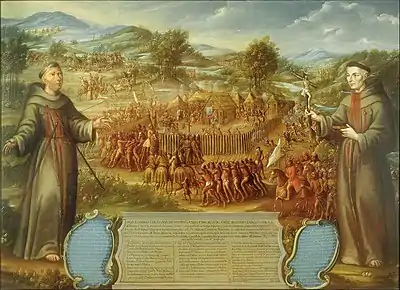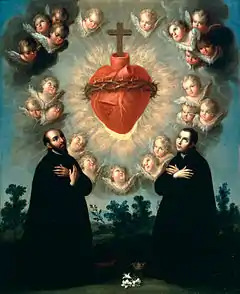José de Páez
José de Páez (1720–1790)[1] was a Mexican painter of religious images, a history painting of the destruction of Mission Santa Cruz de San Sabá in Texas, and a set of casta paintings in the 18th century. He was of Baltazar de Páez, José is identified student of Nicolás Enríquez.[2] He married Rosalía Caballero in 1753.[3]

.
Biography
His works were well-known in New Spain (Mexico), the Peruvian Viceroyalty and Spain. He followed Miguel Cabrera's style. He was known as an artist of religious pieces with special preference on Marian devotions, and as one of the most prolific artists from de New Spain. Art historian Manuel Toussaint said that "José de Páez inundated the second half of the 18th century with his paintings" going on to dismissively say "Among this infinity of pictures, some have interest, as with all artists; but it is difficult to name one that is entirely respectable."[4] However, his work has been more favorably assessed by other art historians. Ilona Katzew describes his style "as sentimental despite the somewhat static and stilted poses of the figures [in his casta paintings], [it] is close to that of Cabrera, which may account for his great success."[5] His paintings have appeared in collections outside of Mexico, so he might have painted for the export market.[6] Some appear in a catalog of Mexican art in Venezuela.[7]
He created several sets of casta paintings, ca. 1780.[8] Two sets are produced in the first full-length work on casta paintings.[9] A third set is in a private collection in Monterrey, Mexico, but shown in San Antonio, Texas as part of an exhibition commemorating the 1718 founding of the settlement. It was published in an earlier exhibition catalogue.[10] The set is typical of the genre, showing racial mixture in hierarchical order. White (Español) - Amerindian mixtures show a return to white status over generations of marriages to whites: Español e India, produce Mestizo; De Español y Mestiza, produce Castizo; De Español y Castiza, produce Español. He then includes an indigenous - Mestizo mixture, with the offspring three-quarters Indio, which is a step down in the racial hierarchy. De Indio, y Mestizo, produce Coyote. The next register is European white - black African mixtures: De Español, y Negra, produce Mulato; De Español, y Mulata produce Morisca; De Español y Morisca, produce Albino; De Español y Albina, produce Torna atrás, a dark "throw back" from very white appearing parents. In the register of Indio - African mixtures, his set is typical in the array of terms that are not standardized in the genre. De Negro, e India, produce Loba; De Lobo e India, produce Chino Cambujo; De Cambujo, e India, produce Sambaigo; De Sambaigo, y Mulata, produce Calpamulata; De Calpamulato, y Coyota, produce Barcina; De Barcino, y Mulata, produced Chino Alvarazado; De Alvarazado, y Torna atrás, produce Tente en el Ayre.[11]
Páez was a favorite painter of the Franciscans. He painted a series on St Francisco Solano in the church of San Fernando in Mexico City.[12][13] He was commissioned to paint the graphic destruction of the Franciscan mission in Texas of San Sabá shows the martyrdom of two Franciscan friars, Fray Alonso Giraldo de Terreros and Fray José de Santiesteban, and the Comanche warriors who wreaked the damage. It is the earliest known painting depicting a scene from the northern region of Texas.[14] The Count of Regla, Don Pedro Romero de Terreros, member of the Order of Calatrava, and a cousin of Fray Alonso, commissioned the oil painting, completed around 1765. Art historian Pedro Ángeles Jiménez's interprets the painting saying it "renders time as if suspended, a sort of setting in which the artist accommodated the episodes of the story, which are only activated when the spectator scrutinizes the order of the inscriptions."[15] The inscriptions are as follows, "A. Presidio of San Sabá and its garrison of one hundred soldiers; B. Road from the presidio to the mission; C. River that divides the mission from the presidio; D. The mission with its fortification, church, and huts; E. Arrival of the barbarous Indians [sic] at the mission; F. Captain General of the army of more than a thousand. G. They come closer to the mission; H. Franciscan father Miguel de Molina comes out to meet them and they talk for along time. the barbarous Indians ask for peace and urge Fr. Molina to accompany them to the presidio. I. Accompanied by a soldier, Fr. Molina leaves for the presidio. The barbarous Indiains shot them twice in the chest, pierced Molina's chest with a spear and scalped him, then stripped both men; J. Clash between the Spanish and the Indians along the road from the presidio, resulting in three deaths and flight back to the presidio and many wounded; K. A brave soldier, with sword in hand, killed many Indians, was pierced through the chest with a spear, and left for dead. He walked to the mission where he was thrown into the fire from which he miraculously escaped and said confession before he died; L. Defense by the Spanish in their huts killing man [Indians]; M. Burning of the mission; N. The death of Padre Santiesteban. He was scalped, decapitated, and clubbed many times. O. Outrage and contempt that they expressed toward the Holy Images and the destruction of the Image of our Lady of Reguge, patron and protector of this mission; P. The miraculous escape during the night of soldiers, women, and children who disappeared in the crowd without being seen; Q. Death of the Administrator of the mission, whose eyes were cut out while he was alive and whose flesh was removed from his body; R. Plunder of the mission."[16] Under the depictions of the two martyred friars are descriptions in the blue medallions with their biographies.
Gallery
 San Juan Nepomuceno. Oil on copper. Art Museum of San Antonio
San Juan Nepomuceno. Oil on copper. Art Museum of San Antonio Holy heart with saint Ignacio de Loyola and Saint Luis Gonzaga. Oil on copper ca. 1770
Holy heart with saint Ignacio de Loyola and Saint Luis Gonzaga. Oil on copper ca. 1770
See also
References
- 1 painting by or after José de Páez, Art UK. Retrieved 13 December 2015.
- Tovar de Teresa, Guillermo. Repertoio de artistas, III, 26.
- Seis siglos de arte.
- Toussaint, Manuel. Colonial Art in Mexico. Austin: University of Texas Press 1967, p. 339.
- Katzew, Casta Painting, p. 21.
- Katzew, Casta Painting, p. 209.
- Duarte, Carlos F. Catálogo de obras mexicanas en Venezuela periodo hispánico. Mexico City: Instituto de Investigaciones Estéticas, UNAM 198, p 21-8.
- Katzew, Ilona. Casta Painting. New Haven: Yale University Press 2004, p. 21.
- María Concepción García Sáiz. Las castas mexicanas. Milan: Olivetti 1989, pp. 197-202, 247-9.
- México eterno: Arte y permanencia. exh. cat. Mexico City: Consejo Nacional para la Cultura y las Artes 1999, 248-53.
- Oettinger, Marion. San Antonio 1718. San Antonio, TX: Trinity University Press and San Antonio Museum of Art 2018, pp. 77-78.
- Romero de Terreros, Manuel. "José de Páez y su Vida de San Francisco Solano," Anales del Instituto de Investigaciones Estéticas 5, no. 17 (1949), 23-6.
- Katzew, Casta Painting, p. 209.
- Oettinger, San Antonio 1718, p. 141.
- Ángeles Jiménez, Pedro in Clara Bargellini and Michael K. Komenecky, eds. The Arts of the Missions of Northern New Spain, 1600-1821. Mexico City: Antiguo Colegio de San Ildefonso 2009, 289-90
- Oettinger, Marion. Translation of the inscription on the painting, in San Antonio 1718, p. 141.
